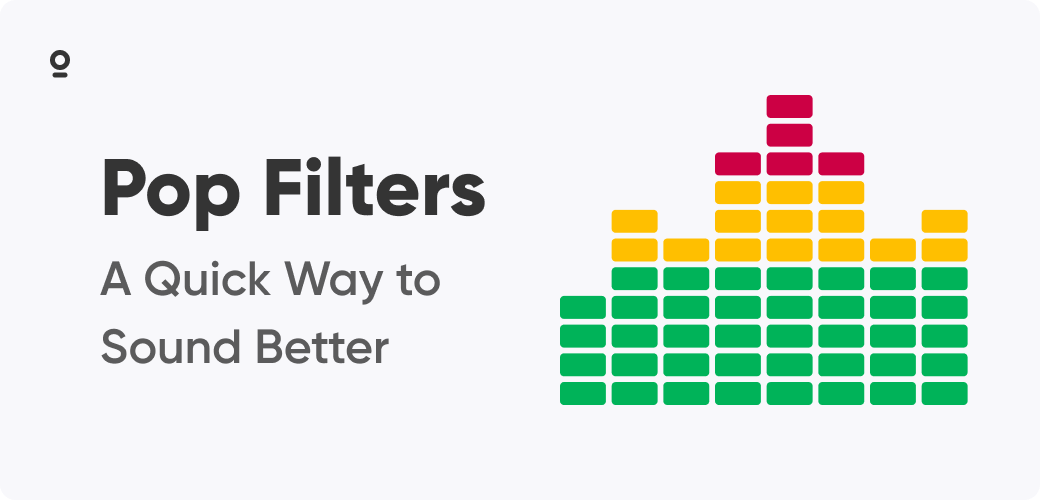With the rise of podcasting and the low barrier of entry, podcasters face the same dilemma as other creators – how do you stand out?
One of the best ways to define your podcast against others in your niche is to create great sound. But there are some things even the best recording software and the most top-shelf microphone can’t defend against, and one of the biggest is plosives – the other being the loud crunch of a bag of chips.
Luckily there is something that can help with the former (though we’d also recommend forgoing eating while you’re recording), the pop filter. They are a low-cost, easy-to-use addition to your podcasting equipment that can go a long way in helping you polish your show.
What are plosives?
Pop filters help defend against plosives – which might not be noticeable when you’re recording but can be very clear to your audience when they’re listening.
You might be familiar with plosives in the context of “popping your Ps.” It’s that extra blast of air that goes hurtling towards your microphone after each P when you say “Peter Piper picked a peck of pickled peppers.” But it’s not just Ps that are to blame – the letters T, K, B, D, and J, are sound quality bandits.
Plosives are a built-in part of speech in the English language – you truly cannot avoid them. They happen when we interrupt the natural airflow of our lungs by completely closing our mouths. This complete closure means that the sound has two separate parts (one on each side) and that the two parts work together to make one unit – the popping P.
As you can imagine, sending a blast of air hurtling at your microphone interrupts good sound quality. Pretty much any microphone picks up those plosives s – and while it’s annoying, the mic is really just doing its job.
Combating the plosive with a pop filter
You can’t really edit out a plosive after the fact.
Depending on how close you are to the microphone and the level of your voice, these plosives can send a few seconds of sound off the charts into unrecoverable space.
Unlike sound that’s recorded too quietly and can be turned up, loud sounds actually distort the audio. That means even the best editors usually can’t fix it.
Plosives are something that needs to be dealt with in a preventative measure, and that measure is called the pop filter.
How do pop filters help get rid of plosives?
Pop filters operate as a form of sound equalizer.
The simplest explanation is that they act as a filter. As sound travels through the filter, the noise is slightly reduced, loud peaks soften, and the audio quality rises.
Unfortunately, pop filters are not magic. If you’re too close to the microphone, your voice is too loud, or the audio gain is at a maximum volume, a pop filter can’t save you. They need to be used in tandem with good levels, a regular voice, and a reasonable distance from the microphone.
But for those that collect good sound for everything but plosives, a pop filter is what you’re missing.
These handy little tools can also help soften and reduce ambient noise. While it likely won’t completely get rid of it, if you’re recording in a noisy environment a pop filter can also help reduce the background noise so your sound is more clear.
Types of pop filters
There are three primary styles of pop filters to choose from:
Nylon mesh
Metal mesh
Foam windscreens
Foam windscreen
Foam windscreens are very cheap and easy to use. Sometimes referred to as a “sock filter” these filters slide right over the grill of your microphone and help break down sound as it goes in.
You’ll find that foam windscreens are most often used with traditional hand-held and boom mics. They’re easy to use right-out-of-the-box, you just slip them on and go, and you can get a whole sleeve of them on Amazon for a few dollars.
Metal mesh
You’ll probably notice that your microphone already has a metal mesh screen built-in. This is the top part of your microphone, or the grill, that you speak into.
While this is technically built to act as a filter, you’ll still want to use a specific pop filter to help give it the extra boost. You’ll notice if you record into the microphone as-is, then put on a pop filter, there will be a noticeable difference in sound.
Now you can actually get an additional metal or steel mesh filter that can help give you that extra protection against plosives. These tend to be mounted screens, and while you can get an affordable one, it’s not going to be quite as inexpensive as that foam windscreen.
However, unlike foam and nylon filters, metal ones are made with the goal of deflecting sound. While your nylon filter breaks down the sound, your metal one bounces it downwards, away from the microphone. These can make for effective plosive deflectors, but you need to get the setup right.
Nylon mesh
Nylon mesh pop filters are probably the most common choice out there.
These are mounted filters made of nylon that diffuse sound as it goes into your microphone. They’re a little more heavy-duty
Prices can range from relatively affordable to expensive.
Can you actually use a sock as a filter?
Technically, if you wanted to, you could slide a plain ole sock over your microphone and call it a pop filter. But a sock that goes on your foot is designed to go on your foot, not to break down sound.
That’s not to say that if you did put a sock over your microphone it wouldn’t record better sound. It’s possible that the knitting of a sock could help break down sound enough to curb some of the popping.
But if you look at the knitting of a sock and a sock filter, you’ll find the audio filter is much puffier and has smaller holes. The density, knitting, and material of a sock would likely also muffle the sound, even if it did get rid of the plosives.
Do lavalier microphones need a pop filter?
Yes, a lavalier microphone can benefit from a pop filter as well.
You might find that plosives aren’t quite as bad on a lapel microphone as they are on one that you speak directly into. That’s because the angle of the microphone means that it usually doesn’t catch the brunt of the plosive.
That said, getting a pop filter for your lavalier microphone is still a good idea. Tiny little sock filters that you can pick up for quite cheap can be added to your lav.
This is a good instance of where a pop filter can help filter out more than just the pops. Podcasters using a lavalier to record on the go in a noisier place, like a cafe, will probably find that adding one will help with background noise.
Finding the right pop filter
The right pop filter for you is the one that’s within your budget and easy for you to use. Simply adding a pop filter to your recording set-up can help reduce the interruption caused by plosives.
It should be said that each microphone will record differently with different pop filters. You might need to try a few before you find the correct one. But, like with a microphone, you don’t need to go to the highest-priced choice to get the best quality.



